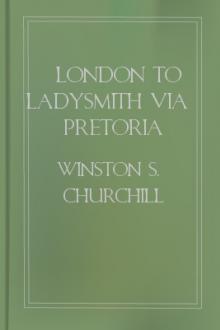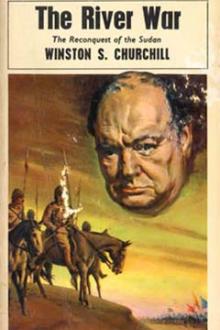London to Ladysmith via Pretoria, Winston Churchill [digital ebook reader txt] 📗

- Author: Winston Churchill
- Performer: -
Book online «London to Ladysmith via Pretoria, Winston Churchill [digital ebook reader txt] 📗». Author Winston Churchill
We had just reached the hollow behind the advanced kopje from which I had watched the attack on the previous evening, when suddenly a shrapnel shell burst in the air above our heads with a sharp, startling bang. The hollow and slope of the hill were crowded with Infantry battalions lying down in quarter column. The bullets and splinters of the shell smote the ground on all sides. We were both mounted and in the centre of the cone of dispersion. I was immediately conscious that nothing had happened to me, though the dust around my horse was flicked up, and I concluded that everyone had enjoyed equally good fortune. Indeed, I turned to Brooke, and was about to elaborate my theory that shrapnel is comparatively harmless, when I saw some stir and turmoil and no less than eight men were picked up killed or wounded by this explosion. I have only once before seen in war such a successful shell, and on that occasion I was studying the effect from the other side.
My respect for modern artillery was mightily increased by this example of its power. Two more shells followed in quick succession. The first struck down four men, and broke in two the leg of an Infantry officer's charger, so that the poor beast galloped about in a circle, preventing his rider from dismounting for some time; the second shore along the Howitzer Battery, killing one soldier and wounding an officer, five soldiers, and three horses. All this occurred in a space of about two minutes, and the three shells between them accounted for nineteen men and four horses. Then the gun, which was firing 'on spec,' and could not see the effect of its fire, turned its attention elsewhere; but the thought forced itself on me, 'Fancy if there had been a battery.' The crowded Infantry waiting in support would certainly have been driven out of the re-entrant with frightful slaughter. Yet in a European war there would have been not one, but three or four batteries. I do not see how troops can be handled in masses under such conditions, even when in support and on reverse slopes. Future warfare must depend on the individual.
We climbed on to the top of the kopje, which was sprinkled with staff officers and others—all much interested in the exhibition of shell fire, which they discussed as a purely scientific question. Inniskilling Hill was still crowned with the enemy, though they no longer showed above their trenches. Its slopes were scored with numerous brown lines, the stone walls built by the attacking brigade during the night, and behind these the telescope showed the Infantry clustering thickly. The Boers on their part had made some new trenches in advance of those on the crest of the hill, so that the opposing firing lines were scarcely three hundred yards apart, which meant that everyone in them must lie still or run grave risks. Thus they remained all day, firing at each other continually, while on the bare ground between them the dead and wounded lay thickly scattered, the dead mixed with the living, the wounded untended, without dressings, food, or water, and harassed by the fire from both sides and from our artillery. It was a very painful thing to watch these poor fellows moving about feebly and trying to wriggle themselves into some position of safety, and it reminded me of the wounded Dervishes after Omdurman—only these were our own countrymen.
It seems that a misunderstanding, of the rights and wrongs of which the reader shall be himself a judge, arose with the enemy. When day broke, the Boers, who were much nearer to the wounded than were our troops, came out of their trenches with a Red Cross flag, and the firing thereupon ceased locally. Our people ought then to have been ready to come forward with another Red Cross flag, and an informal truce might easily have been arranged for an hour or two. Unfortunately, however, there was some delay on our part. The Boers therefore picked up their own wounded, of whom there were a few, gave some of our men a little water, and took away their rifles. All this was quite correct; but the Boers then proceeded to strip and despoil the dead and wounded, taking off their boots and turning out their pockets, and this so infuriated the watching soldiers behind the wall that they forthwith fired on the Boers, Red Cross flag notwithstanding. This, of course, was the signal for fighting to recommence fiercely, and during the day neither side would hear of parley. The Boers behaved cruelly in various instances, and several wounded men who tried to crawl away were deliberately destroyed by being shot at close quarters with many bullets.
During the 24th there was heavy firing on both sides, but no movement of infantry on either. The army suffered some loss from the Boer artillery, particularly the automatic guns, which were well served, and which enfiladed many of our positions on the slopes of the low kopjes. In this way Colonel Thorold, of the Royal Welsh Fusiliers, and other officers, met their deaths. The casualties were principally in Hildyard's English and Kitchener's Lancashire Brigades. Hart's six battalions found good cover in the gorge of the Tugela.
Sir Redvers Buller now saw that his plan of filing his army round the angle of the river and across the enemy's front would, in any case, be very costly, and was perhaps impossible. He, therefore, determined to get back to the Hlangwani plateau, and try the extreme left of the enemy's position. He had the strategic advantage of being on interior lines, and was consequently able to move his troops with great ease from one flank to the other. His new plan was to pass the brigades of his left and centre across the pontoon bridge from the left to the right, so that Hart, who was formerly the extreme right, would now become almost the extreme left, and, having thus extended his right arm, to cross the river where it flowed east and west, and make a still wider swoop on the enemy's flank.
The first thing to do was to move the heavy guns, and this, with certain redistributions of the cavalry, occupied the whole day. A long-range four-gun naval battery was established on the western slopes of the Monte Cristo ridge. Another similar battery was placed on the spurs of Hlangwani. The 4.7-inch naval guns and the 5 in. fortress battery were brought into line in the centre of the Hlangwani plateau. All this was good. The big guns were getting back on to the big hills. The firing, which continued all day, swelled into a roar towards night as the Boers made vigorous attempts to drive Hart's Brigade from its lodgments. They were, however, foiled in their endeavour to squeeze in between the troops and the river.
The battalions, who were attacked frontally, lay down with fixed bayonets and prayed that the Boers might be encouraged by their silence to make an assault. The latter, however, were fully aware of the eagerness of the soldiers for personal collision, and kept their distance. The firing on both sides was unaimed, and very little harm was done. No one, however, had much sleep. The condition of the wounded, still lying sore and thirsty on the bare hillside, was now so shocking that Sir Redvers Buller was forced, much against his inclination, at dawn on the 25th, to send in a flag of truce to the Boer commander and ask for an armistice. This the Boers formally refused, but agreed that if we would not fire on their positions during the day they would not prevent our bearer companies from removing the wounded and burying the dead.
The arrangement worked well; the enemy were polite to our medical officers, and by noon all the wounded had been brought down and the dead buried. The neglect and exposure for forty-eight hours had much aggravated the case of the former, and the bodies of the dead, swollen, blackened, and torn by the terrible wounds of the expansive bullets, now so generally used by the enemy, were ugly things to see. The fact that no regular armistice was agreed on was an advantage, as we were not thereby debarred from making military movements. The Boers improved their entrenchments, and Sir Redvers Buller employed the day in withdrawing his train across the river. This movement, seeming to foreshadow another retreat, sorely disquieted the troops, who were only reassured by the promise of a general onslaught from the other flank at no distant time.
The strange quiet of this Sunday, the first day since the 14th of the month unbroken by musketry and cannonade, was terminated at nine o'clock at night.
The Boers had seen the waggons passing back over the bridge, and were anxious to find out whether or not the infantry were following, and if the low kopjes were evacuated. They therefore opened a tremendous magazine fire at long range on the brigades holding the line from Colenso village to the angle of the river. The fusillade was returned, and for ten minutes the musketry was louder than at any other time in this campaign. Very few casualties occurred, however, and after a while the Boers, having learned that the positions were still occupied, ceased firing, and the British soon imitated them, so that, except for the ceaseless 'sniping,' silence was restored.
At dawn on the 26th the artillery re-opened on both sides, and during the day a constant bombardment was maintained, in which we, having more guns, fired the greater number of shells, and the Dutch, having larger targets, hit a greater number of men. The losses were not, however, severe, except in view of the fact that they had to be endured by the infantry idly and passively.
Considerable movements of troops were made. Colenso and the kopjes about Fort Wylie were converted into a bridgehead, garrisoned by Talbot Coke's Brigade. A new line of communications was opened around the foot of Hlangwani. A pontoon bridge (B) was arranged ready to be thrown below the falls of the river, not far from the still intact Boer bridge. Hildyard's English Brigade stood fast on the advanced low kopjes forming the extreme left of the line. Hart's command held its position about the slopes of Inniskilling Hill and in the gorge of the river. Barton's Fusilier Brigade, Kitchener's Lancashire Brigade, and the two remaining battalions of Norcott's (formerly Lyttelton's) Brigade crossed the old bridge to the Hlangwani plateau.
All was now ready for the final attack on the left of the Pieters position, and in spite of the high quality of the Infantry it was generally recognised throughout the army that the fate of Ladysmith must depend on the success of the next day's operations. The spirit of the army was still undaunted, but they had suffered much from losses, exposure, and disappointment.
Since January 11, a period of more than six weeks, the troops had been continuously fighting and bivouacking. The peaceful intervals of a few days had merely been in order to replenish stores and ammunition. During this time the only reinforcements to reach the army had been a few drafts, a cavalry regiment, a horse battery, and some heavy guns. Exclusive of the 1,100 casualties suffered at Colenso in December, the force, rarely more than 20,000 men, had had over 3,500 killed and wounded, had never had a single gleam of success, and had hardly seen the enemy who hit them so hard.
Colenso, Spion Kop, Vaal Krantz, and the third day at Pieters were not inspiring memories, and though everyone was cheered by





Comments (0)